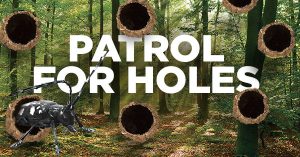
August is the most critical time of year to spot the Asian longhorned beetle (ALB) as adult activity peaks. As a result, the U.S. Department of Agriculture (USDA) has declared August as “Tree Check Month” for this invasive pest. USDA and its partners are working to eradicate the tree-killing beetle in Massachusetts, New York, Ohio, and South Carolina. However, landscaperes in all states should keep an eye out for any new incursions.
“We’re asking for the public’s help to find Asian longhorned beetle and any tree damage it causes, because the sooner we know where the insect is, the sooner we can stop its spread,” said Josie Ryan, APHIS’ National Operations Manager for the ALB Eradication Program. “Just last year, a homeowner in South Carolina reported finding a beetle in their backyard, which led us to discover an active infestation in the state where we didn’t know the beetle was.”
As many landscapers know, ALB is an invasive wood-boring beetle that attacks 12 types of hardwood trees in North America, such as maples, elms, buckeyes, birches, and willows. Infested trees do not recover and eventually die. Infested trees also become safety hazards since branches can drop and trees can fall over, especially during storms. In its larval stage, the insect feeds inside tree trunks and branches, creating tunnels as it feeds, then adults chew their way out in the warmer months, leaving about 3/4″ round exit holes.
The adult beetle has distinctive markings that are easy to recognize:
- A shiny black body with white spots that is about 1” to 1 1/2” long.
- Black and white antennae that are longer than the insect’s body.
- Six legs and feet that can appear bluish in color.
Signs that a tree might be infested include:
- Round exit holes in tree trunks and branches about the size of a dime or smaller.
- Egg sites that are shallow, oval, or round wounds in the bark where sap might weep.
- Sawdust-like material called frass found on the ground around the tree or on the branches.
- Branches or limbs falling from an otherwise healthy-looking tree.
If you think you found a beetle or tree damage, report it by calling the ALB hotline at 1-866-702-9938 or submitting an online report at www.AsianLonghornedBeetle.com. Try to photograph the ALB or tree damage. If you can, capture the beetle in a durable container and freeze it, which helps preserve the insect for identification. Then report it.
If you work in an ALB quarantine area, landscapers are subject to state and federal laws, which restrict the movement of firewood, woody material, and nursery stock that could be infested. For more information about the ALB and the eradication efforts, visit www.AsianLonghornedBeetle.com. For local inquiries or to speak to your USDA State Plant Health Director, call 1-866-702-9938.
It is possible to eradicate the pest. USDA and its partners eradicated the insect from Illinois, Boston in Massachusetts, New Jersey, and portions of New York and Ohio.
Want to read more tree care articles? Visit Tree Services®, part of the Turf family.
Want to talk with peers about tree care, visit the Tree Care Forums on www.expired-link.com, another member of the Turf family.











![[VIDEO] Dickies®: Discover Workwear That’s Anything But Uniform](https://turfmagazine.com/wp-content/uploads/2023/06/1647663814-4b1a2a7742790a9b1e97a3b963477850192e1d6a9dfba9b07214a77bae25d6e3-d-218x150.jpg)





























![[VIDEO] Dickies®: Discover Workwear That’s Anything But Uniform](https://turfmagazine.com/wp-content/uploads/2023/06/1647663814-4b1a2a7742790a9b1e97a3b963477850192e1d6a9dfba9b07214a77bae25d6e3-d-324x160.jpg)